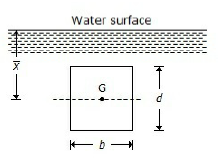Buoyant force is
Resultant force acting on a floating body
Equal to the volume of liquid displaced
Force necessary to keep a body in equilibrium
The resultant force on a body due to the fluid surrounding it
Correct Answer :
D. The resultant force on a body due to the fluid surrounding it
Related Questions
One litre of water occupies a volume of
100 cm3
250 cm3
500 cm3
1000 cm3
Hydrometer is used to determine
Specific gravity of liquids
Specific gravity of solids
Specific gravity of gases
Relative humidity
Which of the following manometer has highest sensitivity?
U-tube with water
Inclined U-tube
U-tube with mercury
Micro-manometer with water
At the center line of a pipe flowing under pressure where the velocity gradient is zero, the shear stress will be
Minimum
Maximum
Zero
Could be any value
The total pressure on the top of a closed cylindrical vessel completely filled up with a liquid is
Directly proportional to (radius)2
Inversely proportional to (radius)2
Directly proportional to (radius)4
Inversely proportional to (radius)4
The value of coefficient of velocity for a sharp edged orifice __________ with the head of water.
Decreases
Increases
Remain same
None of these
A vessel of 4 m3 contains oil which weighs 30 kN. The specific weight of the oil is
4.5 kN/m3
6 kN/m3
7.5 kN/m3
10 kN/m3
The mass per unit volume of a liquid at a standard temperature and pressure is called
Specific weight
Mass density
Specific gravity
None of these
The specific weight of sea water is __________ that of pure water.
Same as
Less than
More than
None of these
A glass tube of smaller diameter is used while performing an experiment for the capillary rise of water because
It is easier to see through the glass tube
Glass tube is cheaper than a metallic tube
It is not possible to conduct this experiment with any other tube
All of the above
Water is a __________ fluid.
Real
Ideal
Newtonian
Non-Newtonian
Which of the following instruments is used to measure flow on the application of Bernoulli's theorem?
Venturimeter
Orifice plate
Nozzle
All of the above
The diameter of the nozzle (d) for maximum transmission of power is given by (where D = Diameter of pipe, f = Darcys coefficient of friction for pipe, and l = Length of pipe)
d = (D⁵/8fl)1/2
d = (D⁵/8fl)1/3
d = (D⁵/8fl)1/4
d = (D⁵/8fl)1/5
The flow in which conditions do not change with time at any point, is known as
One dimensional flow
Uniform flow
Steady flow
Turbulent flow
The pressure less than atmospheric pressure is known as
Suction pressure
Vacuum pressure
Negative gauge pressure
All of these
The most efficient section of a channel is
Triangular
Rectangular
Square
Trapezoidal
The length AB of a pipe ABC in which the liquid is flowing has diameter (d1) and is suddenly contracted to diameter (d2) at B which is constant for the length BC. The loss of head due to sudden contraction, assuming coefficient of contraction as 0.62, is
v₁²/2g
v₂²/2g
0.5 v₁²/2g
0.375 v₂²/2g
The maximum discharge over a broad crested weir is
0.384 Cd × L × H1/2
0.384 Cd × L × H3/2
1.71 Cd × L × H1/2
1.71 Cd × L × H3/2
Buoyant force is
The resultant force acting on a floating body
The resultant force on a body due to the fluid surrounding it
Equal to the volume of liquid displaced
The force necessary to maintain equilibrium of a submerged body
The velocity through a channel of circular section will be maximum when the depth of water is __________ the diameter of the circular channel.
0.34 times
0.67 times
0.81 times
0.95 times
A fluid which obeys the Newton's law of viscosity is termed as
Real fluid
Ideal fluid
Newtonian fluid
Non-Newtonian fluid
The surface tension of mercury at normal temperature compared to that of water is
More
Less
Same
More or less depending on size of glass tube
The body will float if the force of buoyancy is __________ the weight of the liquid displaced.
Equal to
Less than
More than
None of these
If a body floating in a liquid returns back to its original position, when given a small angular displacement, the body is said to be in
Neutral equilibrium
Stable equilibrium
Unstable equilibrium
None of these
For a body floating in a liquid the normal pressure exerted by the liquid acts at
Bottom surface of the body
C.G. of the body
Metacentre
All points on the surface of the body
The imaginary line drawn in the fluid in such a way that the tangent to any point gives the direction of motion at that point, is known as
Path line
Stream line
Steak line
Potential line
Liquids transmit pressure equally in all the directions. This is according to
Boyle's law
Archimedes principle
Pascal's law
Newton's formula
A vertically immersed surface is shown in the below figure. The distance of its centre of pressure from the water surface is 
(bd²/12) + x
(d²/12 x) + x
b²/12 + x
d²/12 + x
The velocity corresponding to Reynold number of 2000 is called
Sub-sonic velocity
Super-sonic velocity
Lower critical velocity
Higher critical velocity
Bulk modulus of a fluid is the ratio of
Shear stress to shear strain
Increase in volume to the viscosity of fluid
Increase in pressure to the volumetric strain
Critical velocity to the viscosity of fluid
